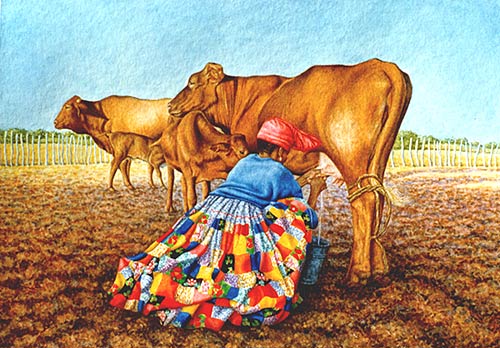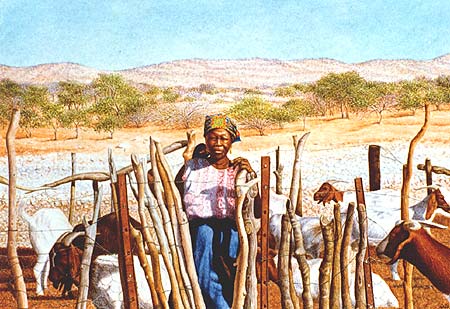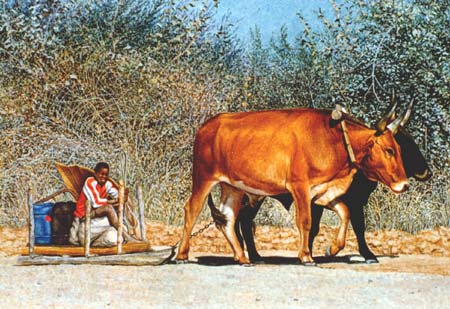BAFA © 2010. All material here is copyrighted. See conditions above. |
Mary Jane Volkmann
painter, (Namibia) U.S.A.
|
This text comes from an interview by Kathleen Hite Babb with Mary Jane Volkmann by email in 1998.
The oldest child and only daughter of the four Barbee children, Mary Jane grew up in Cleveland, Ohio, USA. Her childhood was one of discovery, for she was always a very "visual" person. Some of her happiest early memories were of sitting at a table drawing pictures of things in her mind and inventing stories about them. She remembers her mother being very encouraging and yet giving her space and privacy to "create". As Mary Jane grew up, she found that those private moments of drawing or painting were very special to her spiritually, because she would talk in her mind to herself and to someone or something wonderful she sensed was out there in the universe.
Mary Jane's first formal course was a summer watercolour class at the Cleveland Institute of Art. She remembers being so excited and knowing that this was what she wanted to do in her life. When it came time for university, she was encouraged to study something that she could make a living at, although she really wanted to do fine arts. So she opted for a program in Art Education. Starting at Eastern Michigan University, she then transferred to Hiram College and finally ended up in an excellent joint program with Case Western Reserve University and the Cleveland Institute of Art. In between she lived for a spell in Meadville, Pennsylvania, where she ran a short program of craft classes at the local homes for the aged and the mentally challenged.
|

Epukiro, opaque watercolour by Mary Jane Volkmann.
|
In 1974, one of Mary Jane's friends who was a Bahá´í pioneer to Swaziland, visited her and encouraged her and other Bahá´ís to pioneer to Africa.
Two weeks later, Mary Jane was in Swaziland with her friend.
|
One day shortly after, as Mary Jane stood in her friend's garden doing a painting, her friend had a visit from the King's personal physician, who was also a Cabinet Minister. He stood behind Mary Jane, watching her paint, but said very little.
One day shortly after, as Mary Jane stood in her friend's garden doing a painting, her friend had a visit from the King's personal physician, who was also a Cabinet Minister. He stood behind Mary Jane, watching her paint, but said very little. A few days after that, she had a call from the Cabinet telling her that she must please come to Mbabane immediately as they wanted to see her.
Mary Jane caught a bus, arrived at the Ministry, and was ushered into a formal room with a long wooden table where she was met by the Permanent Secretary. He brought out a portfolio and told her quite simply that the King had had his portraits done for his 75th birthday and didn't like them and wanted to know if she would do new ones to be used for a special issue of stamps for the commemoration! She, of course, told him she would love to, but that she didn't have a work permit, she didn't have the right supplies necessary and couldn't get them in Swaziland. To add to this she didn't have a visa for South Africa, nor the transport and finances to get there to get the supplies. Within four hours she had a work permit, a visa for South Africa, an expense account and a chauffeur waiting to take her to South Africa! That is how her career got started.
|

Near the Grootberg, Damaraland, by Mary Jane Volkmann, Namibia.
|
She did three portraits of the King at different ages. The one most special to her was of him as a child with his mother. Summoned to the office of another Minister, one of the Princes told her that the King had kept that one as it was too precious to him to be used on a postage stamp.
In its place she was given a tiny watermarked photo of the King's grandmother to be made into a portrait, the painting of which she remembers doing as a mysterious portrait because there was no way she could really see the face. |

In the Kavango, opaque watercolour by Mary Jane Volkmann.
|
Someone later touched it up with black outlines and white highlights before it was printed! Mary Jane was then asked to do another issue of stamps for the International Women's Year and after that was commissioned to do coin designs for several different countries, as well as illustrations for a few Bahá´í publications.
|
Moving to Namibia in 1979 (which at that time was still South West Africa), she took a job with the office of the Geological Survey, a division of the south African Geological Survey. She didn't know anything about cartography, and the agency sent her to South Africa for training. Mary Jane set up the first cartographic department of South West Africa/Namibia, produced full colour maps and trained other cartographers. She loved the work, which she did for six years. Eventually she met and married a German Namibian.
When their oldest son was nearly two years and the youngest only four months, the family moved to Tsumeb, four hours to the north of the capital, Windhoek. Tsumeb, being a mining town, seemed to Mary Jane to need more activity in the field of the arts. So she contacted the Town Council and organized an art competition to try and identify those who were interested in art. In the process she realized that the town needed an arts centre, and the Town Council helped her locate premises. Martin Aiff, who had managed an arts centre in Windhoek, came to look at the premises and subsequently moved to Tsumeb with his wife, Gerda. Together he and Mary Jane founded the Tsumeb Arts and Crafts Centre, which is a development education centre for the arts.
At the time, Mary Jane was working on a commission from Gamsberg Macmillan Publishers to do twenty-four miniature paintings for use a greetings cards. When she had completed the first eight, they decided that rather than having her do greeting cards, they would like to publish her paintings as a book, and commissioned her to do thirty paintings depicting life in Namibia. Many of the traditional ways of life were quickly being replaced, as a result of capital and foreign investments that were pouring into the country. Macmillan requested Mary Jane to do the paintings as small and as detailed and realistic as possible, as they intended to produce them as a collection - not just a book of paintings but an historical record as well. The paintings took Mary Jane four and a half years, after which she wrote text to accompany each picture. The book, 'Glimpses of Namibian Life: Moment in Time', was launched in October 1997 and was highly successful. The collection itself was purchased from the publisher for a museum at a cultural centre outside Windhoek.
In addition, earlier this year Mary Jane completed a commission for the Philatelic Bureau of Namibia to do four stamps, a mini-sheet and first day cover of Namibian shells. This series is being released as a special issue for the International exhibition in Lisbon, Portugal, in May 1998.
Mary Jane now lives in Windhoek with her family and is busy with a series of oil paintings. As to her work, she explains: "I love colour and detail and am particularly moved by the spirit of life in each atom of existence. '…if we ponder each created thing, we shall witness a myriad perfect wisdoms…' - Bahá'u'lláh.
I remember being mesmerized by the concept of worlds within worlds after reading from "The Seven Valleys and the Four Valleys": 'Split the atom's heart and lo! Within it thou wilt find a sun' and 'In the ocean he findeth a drop, in a drop he beholdeth the secrets of the sea'. I am also stirred by the concept that the things we see in this world are a reflection of the spiritual world. Pondering the stars at night, sitting in nature watching and listening, hearing the wind build up from a distance and blow across the bush, feeding, watching and listening to the song of the birds, meditating on the changing sky and the billowing clouds, sensing the fragrances of nature, looking through kaleidoscopes and electron microscopes and listening to beautiful music fill me with awe and ecstasy."
She feels that if her paintings can bring even a bit of that joy and happiness, a bit of upliftment and inspiration to those who look at them, she would be very happy. The hours she spends at her work she finds very moving, and she hopes that some of that spirit will come through to others. That is what she most desires to contribute through her art.
Mary Jane Volkmann's book, "Glimpses of Namibian Life/A Moment in Time" can be ordered from Gamsberg Macmillan Publishers, PO Box 22830, Windhoek, Namibia, Africa:ISBN 99916-0-097-3.
|

Arts Dialogue, Dintel 20, NL 7333 MC, Apeldoorn, The Netherlands
email: bafa@bahai-library.com
|
|


